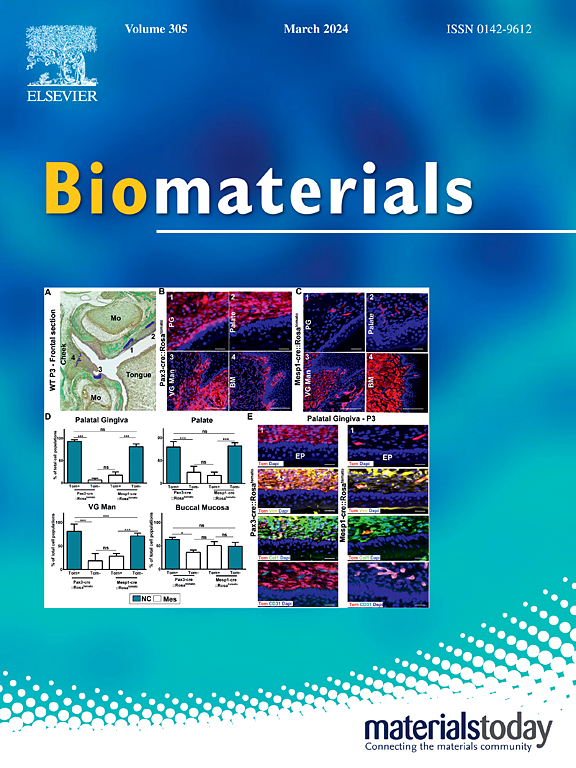Tailoring osteoimmunity and hemostasis using 3D-Printed nano-photocatalytic bactericidal scaffold for augmented bone regeneration
IF 12.8
1区 医学
Q1 ENGINEERING, BIOMEDICAL
引用次数: 0
Abstract
Bone hemorrhage, infection, and large bone defects following surgical treatment of traumatic bone injury have raised potential concerns, underscoring the urgent need to develop multifunctional therapeutic platforms that can effectively address traumatic bone regeneration. Advancements in three-dimensional (3D) printing technology have propelled the development of several engineering disciplines, such as tissue engineering. Nevertheless, 3D-printed frameworks with conventional materials often lack multifunctional capabilities to promote specific activities for diverse regeneration purposes. In this study, we developed a highly oxidized two-dimensional (2D) graphitic carbon nitride (Ox-gCN) as a nano-photocatalyst to reinforce alginate/gelatin (ALG)-based hydrogel scaffolds (ALG/CN) to achieve an anti-inflammatory and osteo-immunomodulatory niche with superior hemostatic ability for traumatic bone injury repair. Sulfuric acid oxidation enhances the oxygen-containing functional groups of the g-CN surface and promotes cell adhesion and differentiation of human bone marrow-derived mesenchymal stem cells (hBMSCs) in vitro. Moreover, the excellent visible light-activated photocatalytic characteristics of the ALG/CN scaffold were used in antibacterial studies. In addition, the ALG/CN bio/nanocomposite scaffold facilitates M2 polarization of macrophages than did pristine ALG scaffolds. Furthermore, ALG/CN scaffold induced hBMSCs differentiation by upregulating ERK and MAPKs phosphorylation during osteo-immunomodulation. In a rat calvaria defect model, the fabricated ALG/CN scaffolds induced new bone formation through collagen deposition and activation of osteocalcin proteins without inflammation in vivo. These results highlight the potential of 3D-printed functionalized 2D carbon nitrides in regulating the bone immune microenvironment, which may be beneficial for developing advanced tissue constructs, especially for traumatic bone regeneration in clinical settings.

使用3d打印纳米光催化杀菌支架增强骨再生的剪裁骨免疫和止血。
外伤性骨损伤手术治疗后的骨出血、感染和大骨缺损引起了潜在的关注,迫切需要开发能够有效解决外伤性骨再生的多功能治疗平台。三维(3D)打印技术的进步推动了一些工程学科的发展,如组织工程。然而,使用传统材料的3d打印框架通常缺乏多功能能力,无法促进不同再生目的的特定活动。在这项研究中,我们开发了一种高度氧化的二维(2D)石墨氮化碳(oxg - gcn)作为纳米光催化剂来增强海藻酸盐/明胶(ALG)基水凝胶支架(ALG/CN),以实现抗炎和骨免疫调节生态位,具有优越的止血能力,用于创伤性骨损伤修复。硫酸氧化增强g-CN表面含氧官能团,促进体外人骨髓间充质干细胞(hBMSCs)的细胞粘附和分化。此外,ALG/CN支架优异的可见光活化光催化特性被用于抗菌研究。此外,与原始ALG支架相比,ALG/CN生物/纳米复合支架促进巨噬细胞M2极化。此外,ALG/CN支架在骨免疫调节过程中通过上调ERK和MAPKs磷酸化诱导hBMSCs分化。在大鼠颅骨缺损模型中,制备的ALG/CN支架通过胶原沉积和骨钙蛋白激活诱导新骨形成,体内无炎症反应。这些结果突出了3d打印功能化二维氮化碳在调节骨免疫微环境方面的潜力,这可能有利于开发先进的组织结构,特别是在临床环境中用于创伤性骨再生。
本文章由计算机程序翻译,如有差异,请以英文原文为准。
求助全文
约1分钟内获得全文
求助全文
来源期刊

Biomaterials
工程技术-材料科学:生物材料
CiteScore
26.00
自引率
2.90%
发文量
565
审稿时长
46 days
期刊介绍:
Biomaterials is an international journal covering the science and clinical application of biomaterials. A biomaterial is now defined as a substance that has been engineered to take a form which, alone or as part of a complex system, is used to direct, by control of interactions with components of living systems, the course of any therapeutic or diagnostic procedure. It is the aim of the journal to provide a peer-reviewed forum for the publication of original papers and authoritative review and opinion papers dealing with the most important issues facing the use of biomaterials in clinical practice. The scope of the journal covers the wide range of physical, biological and chemical sciences that underpin the design of biomaterials and the clinical disciplines in which they are used. These sciences include polymer synthesis and characterization, drug and gene vector design, the biology of the host response, immunology and toxicology and self assembly at the nanoscale. Clinical applications include the therapies of medical technology and regenerative medicine in all clinical disciplines, and diagnostic systems that reply on innovative contrast and sensing agents. The journal is relevant to areas such as cancer diagnosis and therapy, implantable devices, drug delivery systems, gene vectors, bionanotechnology and tissue engineering.
 求助内容:
求助内容: 应助结果提醒方式:
应助结果提醒方式:


